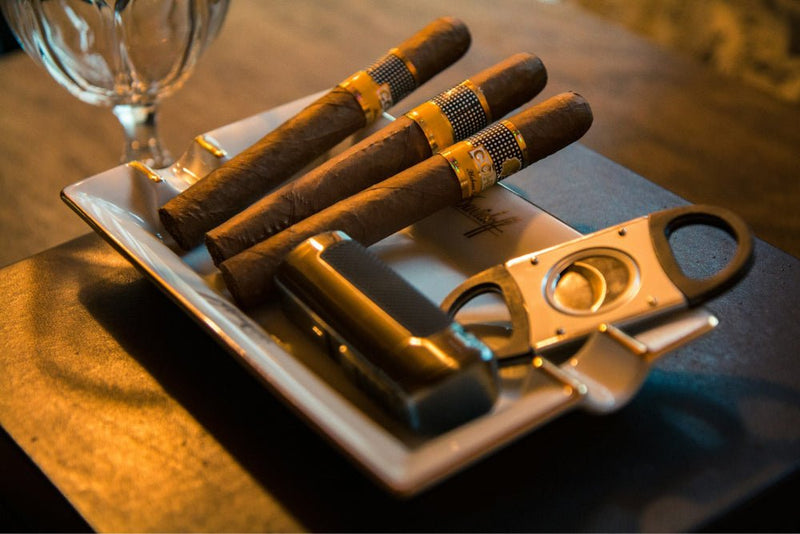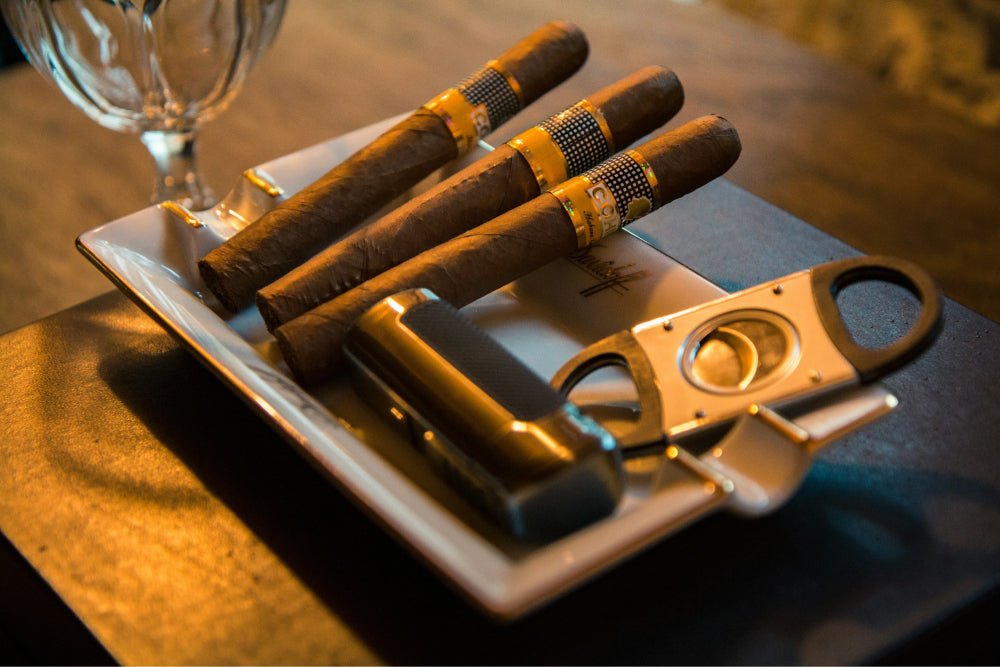
The Ultimate Guide to Cigars: A Journey Through Flavour, Craftsmanship, and Culture
For centuries, cigars have represented sophistication, tradition, and an appreciation for craftsmanship. Whether you’re a seasoned aficionado or a curious newcomer, understanding the nuances of cigars can elevate your smoking experience. This ultimate guide will walk you through the essential elements of cigars, from selecting the right one to proper storage and enjoyment.
1. Understanding the Anatomy of a Cigar
A cigar might appear simple, but its construction is a complex blend of art and science. Each cigar consists of three main parts:
– Wrapper: The outermost layer, which significantly influences the flavour. Wrappers vary in colour from light (Claro) to dark (Oscuro), each offering a unique taste profile.
– Binder: This is the layer beneath the wrapper that holds the cigar together. While it doesn’t contribute much to flavour, its quality is crucial for the cigar’s overall construction.
– Filler: The filler is the heart of the cigar, composed of tobacco leaves that give the cigar its body and character. The combination of filler leaves, often referred to as the blend, is where the artistry truly lies.
2. Types of Cigars: Choosing the Right Shape and Size
Cigars come in a wide variety of shapes and sizes, each offering a different smoking experience. The two most common categories are Parejos and Figurados.
– Parejos are straight-sided cigars, and they include popular types like Robustos, Coronas, and Churchills. They offer an even burn and are ideal for beginners.

– Figurados have a more complex shape, such as Torpedos or Perfectos. Their tapered ends often concentrate the flavours, making for a more dynamic experience but requiring a bit more expertise to smoke properly.

When selecting a size, keep in mind that the length (in inches) and the ring gauge (diameter) influence the smoking time and the intensity of flavours. A larger ring gauge offers a cooler, more complex smoke, while a smaller gauge delivers a quicker, more intense hit.
3. The Importance of Cigar Regions
Just like wine, cigars derive their flavour from the region where their tobacco is grown. The most renowned cigar-producing countries are:
– Cuba: Known for producing the world’s most famous cigars, Cuban cigars like the Cohiba and Montecristo are celebrated for their rich, complex flavours and are often considered the gold standard.
– Dominican Republic: Dominican cigars are known for their smooth, mild, and aromatic qualities. Popular brands include La Galera and La Flor Dominicana.
– Nicaragua: Known for bold, full-bodied cigars, Nicaragua’s volcanic soil produces robust and earthy tobacco. Joya de Nicaragua, Oliva and Padron are top choices from this region.
– Honduras: Offering a range of flavours from medium to full-bodied, Honduran cigars are gaining popularity for their unique spice and woodsy undertones. Rocky Patel and Alec Bradley are great examples of top quality cigars from here.
–Mexico: The home of the San Andres Maduro wrapper that so many cigars contain offering a rich and complex flavour profile. Casa Turrent are outstanding cigars from Mexico that are certainly a must-try.
4. How to Choose the Right Cigar for Your Taste
When choosing a cigar, it’s essential to consider the following factors:
– Strength: Cigars range from mild to full-bodied. Beginners might prefer a mild cigar, such as a Macanudo, which offers a smooth, easygoing smoke. More experienced smokers may enjoy a full-bodied Nicaraguan cigar with stronger flavours and more nicotine content.
– Flavour Profile: Cigars can offer notes of coffee, spice, leather, wood, and even chocolate. If you’re new to cigars, start with milder flavours and work your way up to more complex profiles.
– Occasion and Time: Consider how much time you have to smoke. A short Robusto takes around 30 minutes, while a large Churchill could last up to two hours. The occasion can also dictate the type of cigar. Celebratory events might call for a more luxurious option like a Cohiba, while a casual get-together may be best suited for something more modest.
5. Proper Cigar Storage: Humidors and Ideal Conditions
Cigars are natural products, and as such, they require specific conditions to stay fresh and maintain their flavour. The key is **humidity**.
– Humidors: A humidor is a must-have for any cigar enthusiast. It’s a box designed to maintain the ideal conditions—typically between 65-70% humidity and 68-72°F. Humidors come in various sizes, from portable travel cases to large, furniture-style boxes that hold hundreds of cigars.
– Avoid Drying Out: Cigars that are too dry will burn too hot and fast, leading to a harsh, unpleasant flavour. Conversely, overly humid cigars can become mouldy or difficult to light.
A Boveda pack is a fool proof method of keeping cigars at humidity. You simply place the pack with your cigars and replace the pack when it has dried out and is hard. They come in a variety of sizes to suit your humidor size.
6. How to Properly Cut and Light a Cigar
Cutting and lighting a cigar is a ritual that requires precision. Here’s how to do it right:
– Cutting: Use a quality cigar cutter—either a guillotine, punch, or V-cutter. Always cut at the cap (the closed end) just enough to create a smooth, open draw. Be careful not to cut too much, as this can unravel the wrapper.
– Lighting: Matches or a butane lighter work best. Avoid using candles or fluid lighters, as they can impart unwanted flavours. Toast the foot of the cigar (the open end) before taking the first puff, rotating it to ensure an even burn.
7. Savouring the Smoke: The Art of Enjoying a Cigar
Smoking a cigar is not about inhaling; it’s about savouring the flavours. Take slow, gentle puffs, allowing the smoke to linger in your mouth before exhaling. Cigars are meant to be enjoyed at a leisurely pace, so take your time to fully experience the range of flavours.

Pairing Cigars with Drinks
Pairing your cigar with a drink can elevate your experience. Classic combinations include:
– Whiskey: Bourbon or Scotch pair beautifully with cigars, their smoky, rich flavours complementing the tobacco.
– Cognac: Aged cognacs offer sweetness and depth, making them a perfect match for medium to full-bodied cigars.
– Coffee: A dark roast coffee or espresso enhances the flavours of many cigars, especially in the morning or after a meal.
–Wine: In general, a fuller bodied and stronger cigar will pair well with a fuller bodied wine and conversely a lighter cigar will pair beautifully with a lighter white wine or Champagne. For example, a Quai d’Orsay goes excellently with Champagne and a sunny day!

8. Cigar Etiquette: The Do’s and Don’ts
For the uninitiated, cigar smoking comes with a set of unwritten rules:
– Don’t Ash Too Soon: Let the ash fall naturally; forcing it off too early can cause an uneven burn.
– Don’t Inhale: Cigars are about flavour, not nicotine intake. Inhaling can overwhelm your senses and cause discomfort.
– Do Take Your Time: Cigars are meant to be enjoyed slowly. Rushing through one defeats the purpose of the experience.

Conclusion: The Legacy of Cigars
Whether you’re indulging in a high-end Cuban or enjoying a beginner-friendly New-World Cigar, cigars offer a unique journey of taste, culture, and tradition. Each cigar is a work of art, carefully crafted to provide an exceptional experience. By understanding the basics—from selecting the right size to proper storage and cutting—you can enhance your appreciation and fully enjoy this time-honoured pastime.



0 comments